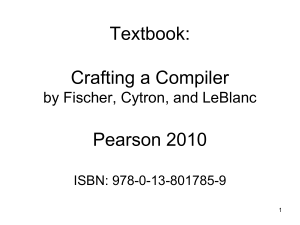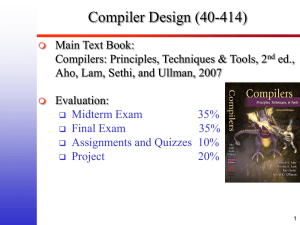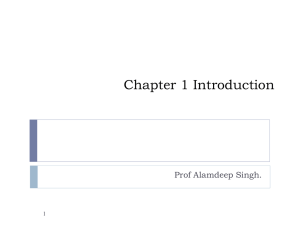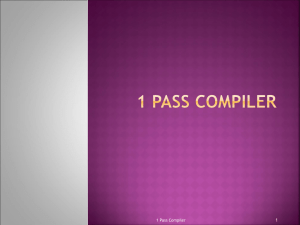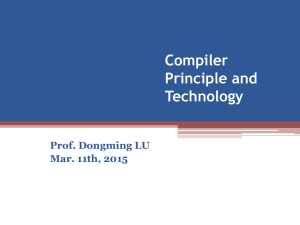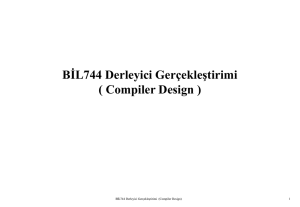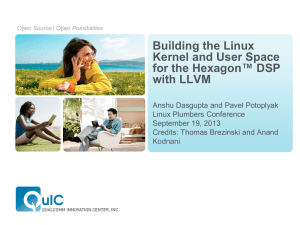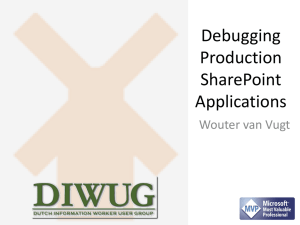Slides
advertisement
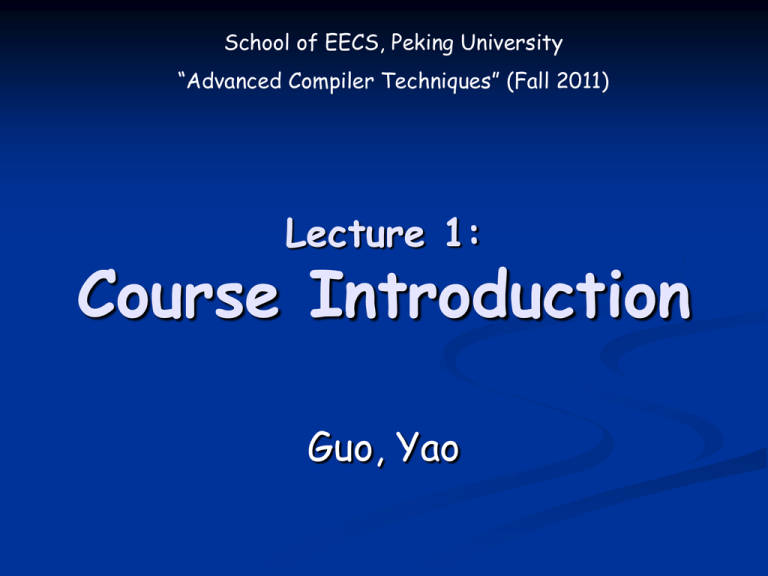
School of EECS, Peking University
“Advanced Compiler Techniques” (Fall 2011)
Lecture 1:
Course Introduction
Guo, Yao
Outline
Course Overview
Course Topics
Course Requirements
Grading
Preparation Materials
Compiler Review
Program Analysis Basics
Fall 2011
“Advanced Compiler Techniques”
2
Course Overview
Graduate level compiler course
Focusing on advanced materials on program
analysis and optimization.
Assuming that you have basic knowledge &
techniques on compiler construction.
Gain hands-on experience through a
programming project to implement a
specific program analysis or optimization
technique.
Course website:
http://sei.pku.edu.cn/~yaoguo/ACT11
Fall 2011
“Advanced Compiler Techniques”
3
Administrivia
Time: 9-12 (6:40pm-) every Thursday
Location: 2-413
TA: TBD
Office Hour: 4-5:30pm Tuesdays
or by appointment thru email
Contact:
Phone: 6275-3496
Email: yaoguo@sei.pku.edu.cn
Include [ACT11] in the subject.
4
Course Materials
Dragon Book
Aho, Lam, Sethi, Ullman, “Compilers: Principles,
Techniques, and Tools”, 2nd ed, Addison 2007
Related Papers
Class website
Fall 2011
“Advanced Compiler Techniques”
5
Requirements
Basic Requirements
Read materials before/after class.
Work on your homework individually.
Get you hands dirty!
Discussions are encouraged but don’t copy others’ work.
Experiment with ideas presented in class and gain firsthand knowledge!
Come to class and DON’T hesitate to speak if you
have any questions/comments/suggestions!
Student participation is important!
Fall 2011
“Advanced Compiler Techniques”
6
Grading
Grading based on
Homework: 20%
~5 homework assignments
Midterm: 30%
Week 10 or 11 (Nov 10/17)
Final Project: 40%
Class participation: 10%
Fall 2011
“Advanced Compiler Techniques”
7
Final Project
Groups of 2-3 students
Pair Programming recommended!
Topic
Problem of your choice (recommend project
list will be provided)
Should be an interesting enough (non-trivial)
problem
Suggested environment
Soot (McGill Univ.)
Joeq, IBM Jikes, SUIF, gcc, etc.
Fall 2011
“Advanced Compiler Techniques”
8
Project Req.
Week 5: Introduction
Week 7: Proposal due
Week 8: Proposal Presentation
Week 13: Progress Report due
Week 16: Final Presentation
Week 17: Final Report due
Fall 2011
“Advanced Compiler Techniques”
9
Course Topics
Basic analyses & optimizations
Data flow analysis & implementation
Control flow analysis
SSA form & its application
Pointer analysis
Instruction scheduling
Localization & Parallelization optimization
Selected topics (TBD)
Program slicing, program testing
Power-aware Compilation
GPU Optimization
Fall 2011
“Advanced Compiler Techniques”
10
About You!
Fall 2011
“Advanced Compiler Techniques”
11
School of EECS, Peking University
“Advanced Compiler Techniques” (Fall 2011)
Compiler Review
What is a Compiler?
A program that translates a program in one
language to another language
Typically lowers the level of abstraction
The essential interface between applications &
architectures
analyzes and reasons about the program &
architecture
We expect the program to be optimized, i.e.,
better than the original
ideally exploiting architectural strengths and
hiding weaknesses
Fall 2011
“Advanced Compiler Techniques”
13
Compiler vs. Interpreter (1/5)
Compilers: Translate a source (humanwritable) program to an executable
(machine-readable) program
Interpreters: Convert a source
program and execute it at the same
time.
Fall 2011
“Advanced Compiler Techniques”
14
Compiler vs. Interpreter (2/5)
Ideal concept:
Source code
Compiler
Executable
Input data
Executable
Output data
Interpreter
Output data
Source code
Input data
Fall 2011
“Advanced Compiler Techniques”
15
Compiler vs. Interpreter (3/5)
Most languages are usually thought of
as using either one or the other:
Compilers: FORTRAN, COBOL, C, C++,
Pascal, PL/1
Interpreters: Lisp, scheme, BASIC, APL,
Perl, Python, Smalltalk
BUT: not always implemented this way
Virtual Machines (e.g., Java)
Linking of executables at runtime
JIT (Just-in-time) compiling
Fall 2011
“Advanced Compiler Techniques”
16
Compiler vs. Interpreter (4/5)
Actually, no sharp boundary between
them. General situation is a combo:
Source code
Intermed. code
Input Data
Fall 2011
Translator
Intermed. code
Virtual machine
“Advanced Compiler Techniques”
Output
17
Compiler vs. Interpreter (5/5)
Compiler
Pros
Interpreter
Less space
Fast execution
Cons
Slow processing
Partly Solved
(Separate compilation)
Improved thru IDEs
Fall 2011
Easy debugging
Fast Development
Cons
Debugging
Pros
Not for large projects
Exceptions: Perl, Python
Requires more space
Slower execution
Interpreter in memory
all the time
“Advanced Compiler Techniques”
18
Phase of compilations
Fall 2011
“Advanced Compiler Techniques”
19
Scanning/Lexical analysis
Break program down into its smallest
meaningful symbols (tokens, atoms)
Tools for this include lex, flex
Tokens include e.g.:
“Reserved words”: do if float while
Special characters: ( { , + - = ! /
Names & numbers: myValue 3.07e02
Start symbol table with new symbols
found
Fall 2011
“Advanced Compiler Techniques”
20
Parsing
Construct a parse tree from symbols
A pattern-matching problem
Language grammar defined by set of rules that
identify legal (meaningful) combinations of symbols
Each application of a rule results in a node in the
parse tree
Parser applies these rules repeatedly to the
program until leaves of parse tree are “atoms”
If no pattern matches, it’s a syntax error
yacc, bison are tools for this (generate c code
that parses specified language)
Fall 2011
“Advanced Compiler Techniques”
21
Parse tree
Output of parsing
Top-down description of program syntax
Root node is entire program
Constructed by repeated application of
rules in Context Free Grammar (CFG)
Leaves are tokens that were identified
during lexical analysis
Fall 2011
“Advanced Compiler Techniques”
22
Example:
Parsing rules for Pascal
These are like the following:
program
PROGRAM identifier (identifier
more_identifiers) ; block .
more_identifiers
, identifier
more_identifiers | ε
block
variables BEGIN statement
more_statements END
statement
do_statement |
if_statement | assignment | …
if_statement
IF logical_expression
THEN statement ELSE …
Fall 2011
“Advanced Compiler Techniques”
23
Pascal code example
program gcd (input, output)
var i, j : integer
begin
read (i , j)
while i <> j do
if i>j then i := i – j;
else j := j – i ;
writeln (i);
end .
Fall 2011
“Advanced Compiler Techniques”
24
Example: parse tree
Fall 2011
“Advanced Compiler Techniques”
25
Semantic analysis
Discovery of meaning in a program using the
symbol table
Do static semantics check
Simplify the structure of the parse tree ( from
parse tree to abstract syntax tree (AST) )
Static semantics check
Making sure identifiers are declared before use
Type checking for assignments and operators
Checking types and number of parameters to
subroutines
Making sure functions contain return statements
Making sure there are no repeats among switch
statement labels
Fall 2011
“Advanced Compiler Techniques”
26
Example: AST
Fall 2011
“Advanced Compiler Techniques”
27
(Intermediate) Code generation
Go through the parse tree from bottom
up, turning rules into code.
e.g.
A sum expression results in the code that
computes the sum and saves the result
Result: inefficient code in a machineindependent language
Fall 2011
“Advanced Compiler Techniques”
28
Machine independent
optimization
Perform various transformations that
improve the code, e.g.
Find and reuse common subexpressions
Take calculations out of loops if possible
Eliminate redundant operations
Fall 2011
“Advanced Compiler Techniques”
29
Target code generation
Convert intermediate code to machine
instructions on intended target machine
Determine storage addresses for
entries in symbol table
Fall 2011
“Advanced Compiler Techniques”
30
Machine-dependent optimization
Make improvements that require
specific knowledge of machine
architecture, e.g.
Optimize use of available registers
Reorder instructions to avoid waits
Fall 2011
“Advanced Compiler Techniques”
31
When should we compile?
Ahead-of-time: before you run the
Offline profiling: compile several times
compile/run/profile.... then run again
Just-in-time: while you run the
program required for dynamic class
loading, i.e., Java, Python, etc.
program
Fall 2011
“Advanced Compiler Techniques”
32
Aren’t compilers a solved problem?
“Optimization for scalar machines is a problem
that was solved ten years ago.”
-- David Kuck, Fall 1990
Fall 2011
“Advanced Compiler Techniques”
33
Aren’t compilers a solved problem?
“Optimization for scalar machines is a problem
that was solved ten years ago.”
-- David Kuck, Fall 1990
Architectures keep changing
Languages keep changing
Applications keep changing - SPEC CPU?
When to compile keeps changing
Fall 2011
“Advanced Compiler Techniques”
34
Role of compilers
Bridge complexity and evolution in
architecture, languages, & applications
Help programs with correctness,
reliability, program understanding
Compiler optimizations can significantly
improve performance
1 to 10x on conventional processors
Performance stability: one line change
can dramatically alter performance
unfortunate, but true
Fall 2011
“Advanced Compiler Techniques”
35
Performance Anxiety
But does performance really matter?
Computers are really fast
Moore’s law (roughly):
hardware performance doubles every 18 months
Real bottlenecks lie elsewhere:
Disk
Network
Human! (think interactive apps)
Human typing avg. 8 cps (max 25 cps)
Waste time “thinking”
Fall 2011
“Advanced Compiler Techniques”
36
Compilers Don’t Help Much
Do compilers improve performance
anyway?
Proebsting’s law
(Todd Proebsting, Microsoft Research):
Difference between optimizing and nonoptimizing compiler ~ 4x
Assume compiler technology represents 36
years of progress (actually more)
Compilers
double program performance
every 18 years!
Not
Fall 2011
quite Moore’s Law…
“Advanced Compiler Techniques”
37
A Big
BUT
Why use high-level languages anyway?
Easier to write & maintain
Safer (think Java)
More convenient (think libraries, GC…)
But: people will not accept massive
performance hit for these gains
Compile with optimization!
Still use C and C++!!
Hand-optimize their code!!!
Even write assembler code (gasp)!!!!
Apparently performance does matter…
Fall 2011
“Advanced Compiler Techniques”
38
Why Compilers Matter
Key part of compiler’s job:
make the costs of abstraction
reasonable
Remove performance penalty for:
Using objects
Safety checks (e.g., array-bounds)
Writing clean code (e.g., recursion)
Use program analysis to transform
code: primary topic of this course
Fall 2011
“Advanced Compiler Techniques”
39
Program Analysis
Source code analysis is the process of extracting
information about a program from its source code
or artifacts (e.g., from Java byte code or
execution traces) generated from the source
code using automatic tools.
Source code is any static, textual, human readable,
fully executable description of a computer program
that can be compiled automatically into an
executable form.
To support dynamic analysis the description can
include documents needed to execute or compile
the program, such as program inputs.
Fall 2011
Source: Dave Binkely-”Source Code Analysis – A Roadmap”, FOSE’07
“Advanced Compiler Techniques”
40
Anatomy of an Analysis
1.
Parser
•
2.
Internal representation
•
•
3.
parses the source code into one or more
internal representations.
CFG, call graph, AST, SSA, VDG, FSA
Most common: Graphs
Actual Analysis
Fall 2011
“Advanced Compiler Techniques”
41
Analysis Properties
Static vs. Dynamic
Sound vs. unsound
Safe vs. Unsafe
Flow sensitive vs. Flow insensitive
Context sensitive vs. Context insensitive
Precision-Cost trade-off
Fall 2011
“Advanced Compiler Techniques”
42
Levels of Analysis
(in order of increasing detail & complexity)
Local (single-block) [1960’s]
Global (Intraprocedural) [1970’s – today]
Straight-line code
Simple to analyze; limited impact
Whole procedure
Dataflow & dependence analysis
Interprocedural [late 1970’s – today]
Whole-program analysis
Tricky:
Very time and space intensive
Hard for some PL’s (e.g., Java)
Fall 2011
“Advanced Compiler Techniques”
43
Optimization =
Analysis + Transformation
Key analyses:
Control-flow
if-statements,
calls
Data-flow
definitions
branches, loops, procedure
and uses of variables
Representations:
Control-flow graph
Control-dependence graph
Def/use, use/def chains
SSA (Static Single Assignment)
Fall 2011
“Advanced Compiler Techniques”
44
Applications
architecture recovery
clone detection
program comprehension
debugging
fault location
model checking in formal analysis
model-driven development
optimization techniques in software engineering
reverse engineering
software maintenance
visualizations of analysis results
etc. etc.
Fall 2011
“Advanced Compiler Techniques”
45
Current Challenges
Pointer Analysis
Concurrent Program Analysis
Dynamic Analysis
Information Retrieval
Data Mining
Multi-Language Analysis
Non-functional Properties
Self-Healing Systems
Real-Time Analysis
Fall 2011
“Advanced Compiler Techniques”
46
Exciting times
New and changing architectures
Hitting the microprocessor wall
Multicore/manycore
Tiled architectures, tiled memory systems
Object-oriented languages becoming dominant
paradigm
Java and C# coming to your OS soon - Jnode, Singularity
Security and reliability, ease of programming
Key challenges and approaches
Latency & parallelism still key to performance
Language & runtime implementation efficiency
Software/hardware cooperation is another key issue
Feedback
Programmer
Fall 2011
Code
H/S Profiling
Compiler
Specification
Code
Runtime
Future behavior
“Advanced Compiler Techniques”
47
Next Time
Control-Flow Analysis
Local Optimizations
Data-Flow Analysis Basics
Read
Dragonbook: §8.4-8.5, §9.1-9.2
Fall 2011
“Advanced Compiler Techniques”
48
